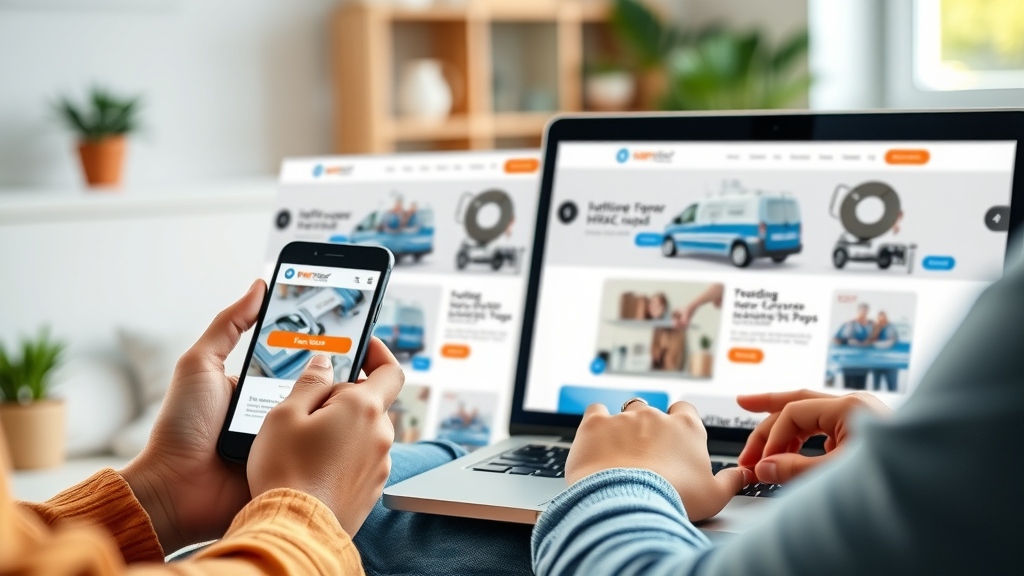Did you know nearly 80% of consumers search online before hiring an HVAC contractor or home service professional? In today’s digital world, where every search is a potential booking, your online presence can make or break your business. Local SEO isn’t just a buzzword—it’s the fastest path to getting your phones ringing and service vans rolling. If you want to be the company customers find first (and choose), mastering the ultimate local SEO strategy for HVAC and home services is non-negotiable.

Why the Ultimate Local SEO Strategy for HVAC and Home Services Matters Now More Than Ever
Almost every HVAC company and home service provider wants to attract more local customers —but competition in the digital marketplace is fierce and growing. With search engines ranking businesses based on relevancy and proximity, being visible in local search engine results isn’t just helpful—it’s vital. If you don’t have a crystal-clear strategy, your next loyal customer could land on a competitor’s page instead of yours.
By embracing the ultimate local SEO strategy for HVAC and home services , you position your company to win the online visibility war. Optimizing your website and Google presence not only attracts highly qualified, local leads but also helps convert them into real, booked appointments. There’s no room for generic approaches—local search demands location-based precision and practical tactics designed for the HVAC and home service industries. Let’s break down exactly what you’ll gain by mastering local SEO for your business:
- Boost online visibility for your HVAC company and home service brand
- Attract qualified local leads and customers
- Consistently outrank competitors in local search results
- Convert website visits into booked service calls
"Nearly 80% of consumers search online before hiring an HVAC contractor or home service professional—making a robust local SEO strategy essential for success."
Understanding Local SEO: How Search Engines Power HVAC Companies & Home Service Growth
Let’s dive into how local SEO really works for HVAC companies and why it’s the secret weapon behind today’s fastest-growing home service brands. When potential customers search for phrases like “AC company near me” or “best HVAC contractor in [your town] ,” search engines use location signals and business relevance to deliver the most useful results. Mastering the mechanics of local SEO means you’re showing up exactly when and where homeowners need you most.

Defining Local SEO for HVAC Companies and Home Service Businesses
Local SEO is a specialized branch of search engine optimization that targets searchers in a specific geographic region—like your service area. Unlike traditional, nationwide SEO, local SEO hones in on the keywords and intent of users looking for nearby help. For HVAC businesses , that means optimizing your presence for local signals: city names, zip codes, neighborhood descriptors, and hyperlocal needs. When you master this, your business dominates for customers just down the street, not just random visitors across the web.
For any ac company or hvac contractor , local SEO helps you show up in the Google “Map Pack” with top spots that lead directly to calls and appointments. Modern local SEO blends traditional optimization (titles, headings, internal links) with powerful off-site tactics such as directory citations and Google Business Profile enhancements—all driving leads to your doorstep.
How Search Engines Process Local Search for HVAC Services
Search engines like Google analyze a variety of cues when someone looks for “hvac services near me.” They scan your site’s keywords, business information, and online reviews—but also cross-reference your data across multiple directories and maps. The result? Only hvac companies with consistent, high-quality signals make it into the coveted “local Map Pack” and top organic search results.
For home service and HVAC business owners, this means the smallest details matter, from having an accurate business address and phone number everywhere to optimizing your site content with neighborhood-specific keywords. Success in local search comes down to authority, relevance, and trust at the local level—let’s see how local SEO compares to traditional SEO:
| Feature | Traditional SEO | Local SEO for HVAC & Home Services |
|---|---|---|
| Target Audience | National/Global | Local/Regional |
| Keywords | Broad | Location-based |
| Search Results | Organic only | Organic + Map Pack |
| Conversion Goals | Traffic | Calls/Leads/Appointments |
Foundation Steps: Keyword Research and Content Creation in the Ultimate Local SEO Strategy for HVAC and Home Services
Building a successful local SEO campaign starts with two things: keyword research and strategic content creation . By identifying what phrases your customers are searching for—and crafting content that answers their exact needs—you show search engines and potential customers alike that your business is the most relevant, trusted solution in your community. Let’s walk through these critical building blocks:
Keyword Research: Pinpointing the Opportunities for HVAC Business Growth

Effective keyword research guides everything you do for local SEO . It’s not enough to guess what your neighbors are searching; you need data-backed insight to focus on the right terms. For hvac contractors aiming for more local searches , smart keyword planning unlocks a list of high-converting phrases specific to your services and geographic area.
Start by targeting ac company and hvac contractor location-based terms, such as “emergency HVAC repair [city],” “best home service provider [neighborhood],” and city-specific service keywords. Use keyword research tools to analyze search volume and competition, and always keep an eye on what local competitors are targeting to find keyword gaps you can own. Here are top tactics for successful keyword research:
- Focus on “ac company” and “hvac contractor” location-specific terms
- Use data-driven keyword tools for search volume and competition
- Analyze local competitors for keyword gaps
- Consider intent for “emergency hvac repair,” “home service estimates,” and more
Content Creation for the Ultimate Local SEO Strategy for HVAC and Home Services
After nailing your keywords, it’s time to put them to work through compelling, value-driven content. Content creation is about more than blogging; it’s your chance to show search engines (and customers) that you’re the local expert homeowners trust. Strong content fuels search ranking , drives leads, and builds your authority in the community and online.
- Location landing pages for each service area
- FAQ resource centers answering common HVAC customer questions
- Blog posts covering seasonal home service tips
- Case studies of successful jobs completed by your team
"Optimized content—and lots of it—ensures search engines recognize your HVAC company as the local authority."
Google Business Profile Optimization: The Backbone of the Ultimate Local SEO Strategy for HVAC and Home Services
Your Google Business Profile (formerly Google My Business) is the cornerstone of your local SEO strategy . When people search online for HVAC companies or home services , a complete and optimized business profile puts your company front and center—often ahead of even your website listing. Here’s how to turn your Google listing into a customer magnet:
Essential Steps to Optimize Your HVAC Company’s Google Business Profile
- Keep your name, address, and phone number (NAP) consistent on every listing
- Select the most accurate business categories (HVAC, home services)
- Include natural keywords in your business description
- Add high-quality images, details on services, and showcase professional certifications
- Regularly encourage and respond to all customer reviews—both positive and negative

Citations, Directories, and Managing Online Presence for the Ultimate Local SEO Strategy for HVAC and Home Services
Getting found online isn’t just about your website–it’s about your online presence everywhere that matters. HVAC contractors and home service businesses rely on directory listings and citation accuracy to signal trust and authority to both search engines and customers. Even minor issues, such as a wrong phone number or outdated address, can send mixed signals and hurt your ranking.
"Even small NAP inconsistencies across online directories can undermine your position in search engine results."
Must-Have Citations & Directory Listings for HVAC Companies and Home Service Providers
Building a web of trusted citations is a foundational part of local SEO . Not all directories are created equal, so prioritize platforms your customers actually use—and where search engines are actively looking for validation. Here are the top platforms for any hvac company :
- Google Business Profile
- Yelp, Angi (Angie’s List), HomeAdvisor
- Your local chamber of commerce
- Specialized home services/HVAC directories
- Bing and Apple Maps
How to Build and Maintain a Cohesive Online Presence
Managing your online presence demands regular attention. It’s crucial to keep your NAP (name, address, phone) data consistent across every channel. Claim, optimize, and update all profiles, and proactively monitor for duplicates or incorrect details. Enhancing your online footprint pays off in higher trust—both for new customers and for Google’s algorithms.
- Regularly audit your NAP across all listings
- Claim and update every relevant business profile
- Use local schema markup for contact/location info on your website
- Check for and address duplicate or outdated business listings

On-Page SEO for HVAC Service Pages: Critical Elements for the Ultimate Local SEO Strategy
Optimizing each service and location page is where the rubber meets the road for local SEO . Search engines rely on signals like titles, metadata, and relevant keywords to ensure your hvac contractor pages show up in local search rankings—and that visitors stick around to become leads.
Proper Use of Local Keywords for HVAC Contractor Service Pages
- Incorporate city, neighborhood, or service area modifiers in title tags , meta descriptions , and URLs
- Integrate primary and secondary keywords naturally (think: “hvac companies,” “ac company,” “home service providers”)
- Use internal links to connect your key local landing pages and service details
By layering these keywords tactically, you help search engines match your business with the right search intent every time. Don’t forget to focus each service page on one specific need (like “emergency hvac repairs in [city]”), giving both search engines and users the clear information they need.
Enhance User Experience & Engagement to Boost Local Search Engine Rankings
- Design your website with mobile users first in mind
- Boost site speed —a slow site can cost you leads
- Install clear, easy-to-use click-to-call buttons for fast booking
- Add thorough FAQ sections answering both HVAC and home service questions
A seamless user experience ensures potential customers can quickly request service—a big signal to Google that your business deserves to rank higher. The goal: make every visitor’s journey from search engine to service request as fast and frictionless as possible.

Localized Content Strategy: Strengthening the Ultimate Local SEO for HVAC and Home Services
Supercharging your local SEO goes beyond keywords. Hyperlocal content —tailored to neighborhoods, communities, or city blocks—cements your role as the hvac company locals trust. When you create content that highlights your work with specific towns, events, or weather patterns, search engines reward you with higher relevance and stronger rankings in those location-based searches.
Why Hyperlocal Content Drives Home Service Leads
Hyperlocal content sets your home service brand apart, driving more targeted leads than generic blog posts ever could. Consider spotlighting neighborhoods, sharing maintenance “how-to” articles based on seasonal needs, or featuring real customer testimonials from key service areas. Recognizing the faces and stories of your community gives prospects instant trust and reassures Google your business is firmly embedded in the area.
- Neighborhood/service area spotlights
- Customer testimonial features by city/zip code
- Weather-specific maintenance articles
- Community event sponsorships or partnerships

Integrating Reviews and Ratings in Your Local SEO Strategy
Online reviews are now one of the most influential factors in local search engine optimization . A strong flow of recent, positive reviews boosts your search engine results and inspires new customers to pick up the phone. Don’t leave review strategy to chance—be proactive in collecting and showcasing them on your landing pages and Google Business Profile.
- Prompt satisfied customers for Google reviews after each completed job
- Highlight glowing, 5-star reviews on key landing pages
- Always respond courteously to every review—positive or negative

Building High-Authority Local Backlinks for the Ultimate Local SEO Strategy for HVAC and Home Services
Backlinks—links from other reputable, local sites—act as endorsements for your business, earning you trust with search engines and customers. For hvac businesses , local backlinks can often be secured via partnerships, sponsorships, and community involvement. Each new high-quality backlink to your site signals your credibility and relevance for local searches .
Effective Tactics for HVAC Business Link Building
- Network with local business organizations and chambers of commerce for mutual digital promotion
- Collaborate with suppliers and other home service providers for co-marketing and guest posting
- Sponsor community events or release press announcements about recent achievements
- Contribute guest articles to industry-relevant and local blogs
"High-quality local backlinks signal authority and trust to every major search engine."

Tracking and Measuring Results of the Ultimate Local SEO Strategy for HVAC & Home Services
The only way to improve your local SEO is to track what works. By monitoring key metrics and making data-driven adjustments, your HVAC or home service business can double down on what delivers leads—and fix what doesn’t. Here’s how to master measurement:
Essential Metrics for Monitoring Local SEO Performance
- Google Business Profile insights
- Map Pack and organic local search rankings
- Call volume and website form submissions
- Website traffic from local queries
Benchmarking these metrics helps reveal where you’re excelling and what needs attention, whether it’s your search rankings , review collection, or conversion rate from potential customers .
Recommended Tools for HVAC Companies to Track Search Engine Optimization Success
- Google Analytics and Google Search Console for traffic, clicks, and crawl issues
- Local rank tracking platforms like Moz, BrightLocal, or Whitespark
- Call tracking software for accurate attribution of phone leads
- Reputation management dashboards for managing and reporting reviews
| Metric | Why It Matters | Benchmark |
|---|---|---|
| Map Pack Ranking | Visibility for local searches | Top 3 |
| Website Conversion Rate | Turning visitors into leads | 10%+ |
| Google Reviews | Builds trust | 50+ reviews, 4.5 stars |

People Also Ask: Optimizing the Ultimate Local SEO Strategy for HVAC and Home Services
How quickly will the ultimate local SEO strategy for HVAC and home services show results?
Results from the ultimate local SEO strategy for HVAC and home services typically begin to appear within 3 to 6 months, though it depends on factors like competition, consistency, and prior online presence. Businesses with a solid foundation and regular updates to their online listings often notice increased traffic and more service calls faster. Remember, SEO is an ongoing process—patience and continuous effort yield the strongest, longest-lasting rankings and visibility.
What are the most important local SEO ranking factors for hvac companies?
Key factors include having an optimized Google Business Profile , consistent NAP data across directories, high-quality reviews, relevant local keywords on service pages, and authoritative local backlinks. Enhancing user experience with fast, mobile-friendly site design and answering the most common search queries also positively impacts your search rankings and visibility in local search results.
Is local SEO different for HVAC contractors versus other home service businesses?
While the core principles of local SEO apply across all home service sectors, hvac contractors may face unique challenges—such as seasonality, emergency service demand, and complex certifications. Tailoring your keyword research, content, and online profiles to reflect the HVAC industry’s specific needs ensures your business stands out from general service competitors and attracts more targeted leads.
Top Frequently Asked Questions About the Ultimate Local SEO Strategy for HVAC & Home Services
How do I pick the best local keywords for my HVAC business?
Start by identifying which services you offer and the specific areas you serve, then use keyword research tools to find popular search phrases that combine your service with your location, such as “ac company [city]” or “emergency hvac repair [zip code].” Consider keywords for both high-intent (emergency services) and general queries, and check what your local competitors rank for to find untapped opportunities.
Do directory citations really impact search engine optimization for home service companies?
Yes, citations are critical for local SEO —they validate your business’s legitimacy in the eyes of search engines . Accurate, consistent NAP information in trusted directories increases your authority, helps your business rank in local search and Google Maps, and provides multiple avenues for potential customers to find and contact you.
Can I improve local SEO without a marketing agency?
Absolutely! While agencies can accelerate results, many HVAC contractors and home service providers make significant SEO progress through self-guided action: updating directory information, creating localized content, requesting reviews, and tracking metrics. Many affordable or free tools exist to help small businesses manage and improve their local search engine optimization on their own.

Action Steps: Implementing the Ultimate Local SEO Strategy for HVAC and Home Services
- Audit your current online presence
- Research and implement high-value local keywords
- Optimize all service and location pages
- Claim and update all directory citations
- Create and execute a review strategy
- Establish high-authority local backlinks
- Track key metrics monthly
- Continuously improve based on results
Maximize Your Growth: Get Started with the Ultimate Local SEO Strategy for HVAC and Home Services
- Invest in the right keyword and content planning
- Focus on Google Business Profile excellence
- Consistently track, measure, and adapt your SEO efforts
Ready to dominate local searches and grow your HVAC or home service business? Start implementing this ultimate local SEO strategy today—or partner with experts and accelerate your results.
To further enhance your understanding of local SEO strategies tailored for HVAC and home service businesses, consider exploring the following resources:
This guide offers practical advice on optimizing your Google Business Profile, targeting local HVAC-related keywords, and creating location-specific service pages to improve your online visibility.
This article delves into the importance of gathering customer reviews, building citations in directories, and developing location-specific landing pages to attract more clients.
By implementing the strategies outlined in these resources, you can effectively boost your online presence and attract more local customers to your HVAC or home service business.
 Add Row
Add Row  Add
Add 



Write A Comment